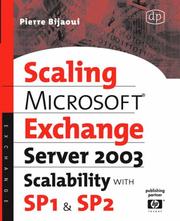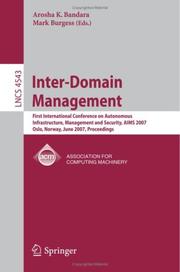| Listing 1 - 3 of 3 |
Sort by
|

ISBN: 9781555583002 1555583008 9780080491851 0080491855 1281007099 9781281007094 9786611007096 6611007091 Year: 2007 Publisher: Burlington, MA Elsevier Digital Press
Abstract | Keywords | Export | Availability | Bookmark
 Loading...
Loading...Choose an application
- Reference Manager
- EndNote
- RefWorks (Direct export to RefWorks)
Microsoft Exchange 2003 Server is the server component that provides electronic messaging in major corporate environments. It has had two updates since its release in 2003, SP1 and SP2. The author covers these along with critical changes in Widows 2003 Server such as the scalability features of the Active Directory and the server and storage technologies. This crucial release borrows from the legacy Exchange system, but also from a myriad of others. The organization of the book provides necessary background on the software and hardware required in order to manage an efficient scalable Microsof
Electronic mail systems. --- Client/server computing. --- Computer networks --- Scalability. --- Microsoft Exchange server.

ISBN: 1281007099 9786611007096 0080491855 1555583008 9781555583002 9780080491851 9781281007094 6611007091 Year: 2007 Publisher: Amsterdam Boston Elsevier Digital Press
Abstract | Keywords | Export | Availability | Bookmark
 Loading...
Loading...Choose an application
- Reference Manager
- EndNote
- RefWorks (Direct export to RefWorks)
Microsoft Exchange 2003 Server is the server component that provides electronic messaging in major corporate environments. It has had two updates since its release in 2003, SP1 and SP2. The author covers these along with critical changes in Widows 2003 Server such as the scalability features of the Active Directory and the server and storage technologies. This crucial release borrows from the legacy Exchange system, but also from a myriad of others. The organization of the book provides necessary background on the software and hardware required in order to manage an efficient scalable Microsof
Electronic mail systems. --- Client/server computing. --- Computer networks --- Scalability. --- Scalability of computer networks --- Computing, Client/server --- E-mail systems --- Electronic message systems --- Email systems --- Electronic data processing --- Data transmission systems --- Telematics --- Voice mail systems --- Distributed processing --- Microsoft Exchange server. --- Microsoft Exchange 2000 --- Information Technology --- General and Others

ISBN: 9783540729853 3540729852 3540729860 Year: 2007 Publisher: Berlin ; Heidelberg : Springer,
Abstract | Keywords | Export | Availability | Bookmark
 Loading...
Loading...Choose an application
- Reference Manager
- EndNote
- RefWorks (Direct export to RefWorks)
Researchneedsideas,discourseandexperimentationinordertothrive,butmore than ever we are expected to make researchimmediately ‘relevant’ and available to society and the world of commerce. Of these three poles (ideas, discourse and experimentation), ideas lie farthest from a ?nished product, and it is therefore ideas that are most easily left behind in the rush to catch the gravy train. The pressure to prioritize applications rather than understanding hinders researchers from thinking deeply about problems, and in the worst case prevents us from truly understanding and innovating. The ?rst Autonomous Infrastructure Management and Security conference (AIMS2007)wasproposedasanactofoptimismbytheleadersoftheEMANICS Network of Excellence in Network and Service Management. It was a proposal aimed at avoiding the tar-pit of “apply existing knowledge only, ” to reach out for new ideas that might expand our network of concepts and solutions. Therearealreadymanyexcellentconferencesinthe?eldofNetworkofSystem Management : LISA, IM, NOMS, DSOM, Policy Workshop, etc. Although there is an overlap, both in attendance and ideas, AIMS does not compete with any of these. Rather we have sought a strong cross-disciplinary forum, in which novelty and discussion are made paramount. An additional objective of AIMS is to provide a forum for doctoral students, the future leaders of our research, to discuss their research with a wider audience and receive training to help make their research careers successful. To this end, AIMS incorporates a European PhD Student Symposium and a tutorial programme that covers a broad range of topics.
Computer networks --- Computer security --- Réseaux d'ordinateurs --- Sécurité informatique --- Management --- Congresses. --- Scalability --- Gestion --- Congrès --- Telecommunications --- Electrical & Computer Engineering --- Engineering & Applied Sciences --- Information Technology --- Computer Science (Hardware & Networks) --- Communication systems, Computer --- Computer communication systems --- Data networks, Computer --- ECNs (Electronic communication networks) --- Electronic communication networks --- Networks, Computer --- Teleprocessing networks --- Computer science. --- Computer communication systems. --- Computer system failures. --- Information storage and retrieval. --- Management information systems. --- Computer Science. --- Computer Communication Networks. --- System Performance and Evaluation. --- Information Systems Applications (incl. Internet). --- Information Storage and Retrieval. --- Management of Computing and Information Systems. --- Computer-based information systems --- EIS (Information systems) --- Executive information systems --- MIS (Information systems) --- Sociotechnical systems --- Information resources management --- Computer failures --- Computer malfunctions --- Computer systems --- Failure of computer systems --- System failures (Engineering) --- Fault-tolerant computing --- Data transmission systems --- Digital communications --- Electronic systems --- Information networks --- Telecommunication --- Cyberinfrastructure --- Electronic data processing --- Network computers --- Informatics --- Science --- Communication systems --- Failures --- Distributed processing --- Computer system performance. --- Information storage and retrieva. --- Information Systems. --- Information storage and retrieval systems. --- Automatic data storage --- Automatic information retrieval --- Automation in documentation --- Data processing systems --- Data storage and retrieval systems --- Discovery systems, Information --- Information discovery systems --- Information processing systems --- Information retrieval systems --- Machine data storage and retrieval --- Mechanized information storage and retrieval systems --- Electronic information resources --- Data libraries --- Digital libraries --- Information organization --- Information retrieval --- Application software. --- Application computer programs --- Application computer software --- Applications software --- Apps (Computer software) --- Computer software --- Autonomic computing.
| Listing 1 - 3 of 3 |
Sort by
|

 Search
Search Feedback
Feedback About UniCat
About UniCat  Help
Help News
News